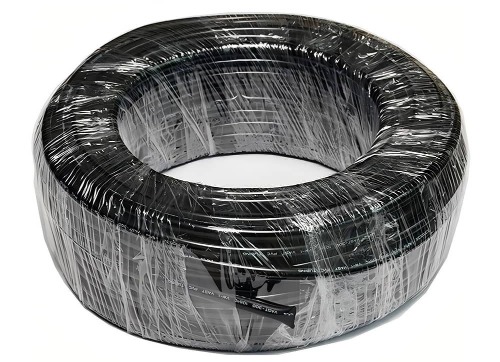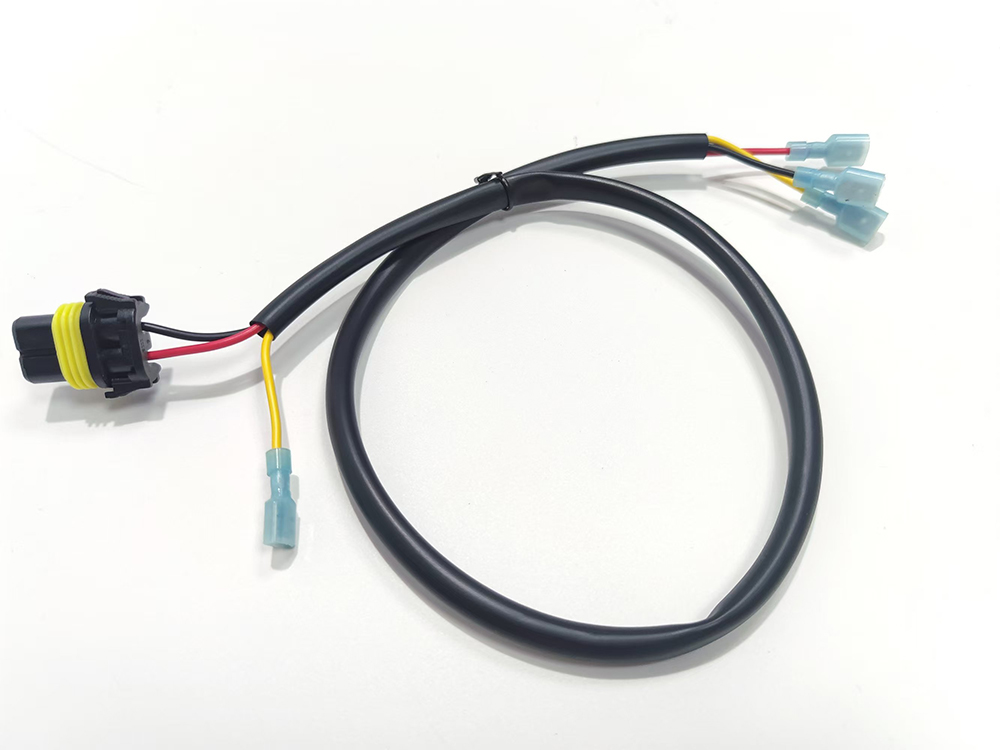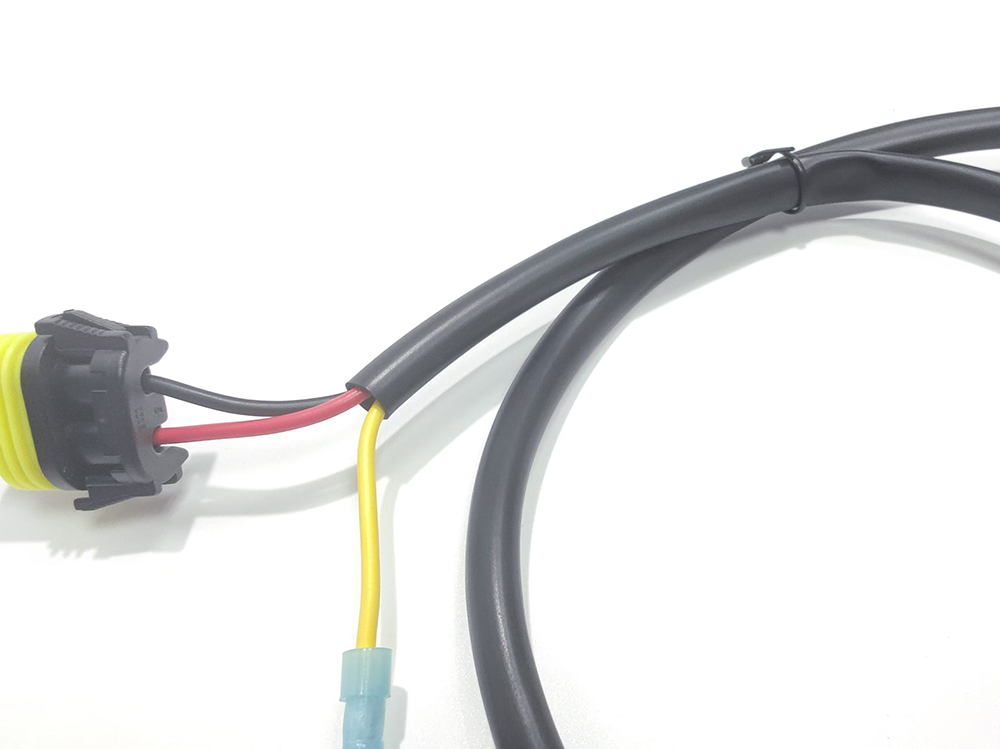Non-shrinking Soft sleeve, PVC or PE?
In industrial wiring systems, protective tubing plays a critical role in ensuring electrical safety, mechanical durability, and environmental resistance. This article provides an in-depth technical analysis of two predominant materials - Polyvinyl Chloride (PVC) and Irradiation-Crosslinked Polyethylene (PE) - examining their properties, certifications, and application considerations through comparative data from specification sheets.

Material Composition & Environmental Profile
PVC Tubing
Composed of flexible polyvinyl chloride polymer, PVC tubing contains chlorine (57% by weight) in its structure, contributing to inherent flame retardancy. While meeting UL 224 VW-1 and JQA F-mark flame standards, traditional PVC formulations may contain plasticizers like phthalates that face increasing regulatory scrutiny under REACH and RoHS directives.
PE Tubing
Utilizing radiation-modified polyolefin base material, PE tubing represents an eco-conscious evolution. The crosslinking process through electron beam irradiation creates a three-dimensional molecular network, enhancing thermal stability without halogen additives. Its RoHS/REACH/SONY compliance and halogen-free composition make it preferable for electronics requiring end-of-life recyclability.
Thermal Performance Benchmarking
Temperature resistance proves crucial in automotive and industrial environments:
| Parameter | PVC | PE |
|---|---|---|
| Continuous Rating | 105°C | 125°C |
| Thermal Shock | 180°C/4h Pass | 180°C/4h Pass |
| Cold Resistance | -30°C Stable | -30°C Stable |
| Copper Corrosion | 136°C/168h OK | 136°C/168h OK |
While both materials withstand short-term 180°C exposures, PE's 20% higher continuous rating makes it suitable for under-hood automotive applications where ambient temperatures frequently exceed 100°C. The identical cold shock performance (-30°C) ensures comparable flexibility in freezer applications.
Electrical Characteristics
Dielectric properties reveal distinct advantages:
| Property | PVC | PE |
|---|---|---|
| Volume Resistivity | ≥1.0×10¹⁰ Ω·cm | ≥1.0×10¹² Ω·cm |
| Breakdown Voltage | 2,500V (60s) | 2,500V (60s) |
| Voltage Rating | 300V/600V | 300V/600V |
| Comparative Tracking Index | Not Specified | Implied Higher |
PE's two-order magnitude greater volume resistivity suggests superior insulation performance in high-impedance circuits. Both materials meet identical dielectric strength requirements, though PE's crosslinked structure provides better resistance to electrochemical migration in humid environments.
Mechanical Properties & Durability
Tensile testing data shows
| Mechanical Parameter | PVC | PE |
|---|---|---|
| Tensile Strength | ≥10.4MPa | ≥10.4MPa |
| Elongation at Break | ≥200% | ≥200% |
| Longitudinal Change | ±5% | ±5% |
| Abrasion Resistance | Moderate | Enhanced |
While tensile specifications appear identical, PE's crosslinked matrix provides better cut-through resistance and memory retention after deformation. Accelerated aging tests show PE maintains >85% initial elongation after 3,000hrs at 121°C versus PVC's 65-70% retention.
Chemical Resistance Profile
PVC demonstrates
- Excellent resistance to acids, alkalis, and oxidizing agents
- Moderate hydrocarbon resistance
- Potential plasticizer migration in oil immersion
PE exhibits
- Superior hydrocarbon resistance (ASTM Grade A)
- Enhanced UV stability without stabilizers
- Reduced extraction in polar solvents
- No chloride ion emission under pyrolysis
Dimensional Specifications
PVC Tubing Matrix
Covers fractional sizes from 5/8" (15.9mm) to #21 (0.79mm) with:
- Wall thickness range: 0.35±0.10mm to 0.70±0.15mm
- Tight diameter tolerance: ±0.15mm to ±0.50mm
PE Tubing Options
Metric sizing from Φ0.9mm to Φ15.6mm featuring:
- Consistent 0.38-0.62mm walls across sizes
- Precision ID control: ±0.05mm to ±0.20mm
- Smooth bore surface (Ra ≤0.8μm)
The PE series offers better size consistency for automated harness processing, while PVC's fractional sizing accommodates legacy designs.
PVC tube Size
| Number | Inside diameter (MM) |
Wall-thickness | |
| 300V | 600V | ||
| 5/8 | 15.9±0.50 | 0.70±0.15 | 0.70±0.15 |
| 9/16 | 14.3±0.50 | 0.70±0.15 | 0.70±0.15 |
| 1/2 | 12.7±0.50 | 0.57±0.15 | 0.57±0.15 |
| 7/16 | 11.1±0.50 | 0.57±0.15 | 0.57±0.15 |
| 3/8 | 9.53±0.50 | 0.57±0.15 | 0.57±0.15 |
| 5/16 | 7.92±0.50 | 0.57±0.15 | 0.57±0.15 |
| 0# | 8.38±0.50 | 0.45±0.15 | 0.57±0.15 |
| 1# | 7.47±0.50 | 0.45±0.15 | 0.57±0.15 |
| 2# | 6.68±0.50 | 0.45±0.15 | 0.57±0.15 |
| 3# | 5.94±0.30 | 0.45±0.15 | 0.57±0.15 |
| 4# | 5.28±0.30 | 0.45±0.15 | 0.57±0.15 |
| 5# | 4.72±0.30 | 0.45±0.15 | 0.57±0.15 |
| 6# | 4.22±0.30 | 0.45±0.15 | 0.57±0.15 |
| 7# | 3.76±0.20 | 0.45±0.15 | 0.57±0.15 |
| 8# | 3.38±0.20 | 0.45±0.15 | 0.57±0.15 |
| 9# | 3.00±0.20 | 0.45±0.15 | 0.57±0.15 |
| 10# | 2.69±0.20 | 0.35±0.15 | 0.57±0.15 |
| 11# | 2.41±0.20 | 0.35±0.10 | 0.57±0.10 |
| 12# | 2.16±0.20 | 0.35±0.10 | 0.57±0.10 |
| 13# | 1.93±0.15 | 0.35±0.10 | 0.57±0.10 |
| 14# | 1.68±0.15 | 0.35±0.10 | 0.57±0.10 |
| 15# | 1.50±0.15 | 0.35±0.10 | 0.57±0.10 |
| 16# | 1.34±0.15 | 0.35±0.10 | 0.57±0.10 |
| 17# | 1.19±0.15 | 0.35±0.10 | 0.57±0.10 |
| 18# | 1.07±0.15 | 0.35±0.10 | 0.45±0.10 |
| 19# | 0.96±0.15 | 0.35±0.10 | 0.45±0.10 |
| 20# | 0.86±0.15 | 0.35±0.10 | 0.45±0.10 |
| 21# | 0.79±0.15 | 0.35±0.10 | 0.45±0.10 |
PE Tube Size
| Number | Inside diameter (MM) |
Wall-thickness | |
| 300V | 600V | ||
| BΦ0.9 | 0.95±0.05 | 0.38±0.05 | 0.50±0.06 |
| BΦ1.4 | 1.45±0.05 | 0.38±0.05 | 0.62±0.06 |
| BΦ2.0 | 2.05±0.05 | 0.38±0.05 | 0.62±0.06 |
| BΦ2.5 | 2.55±0.05 | 0.38±0.05 | 0.62±0.06 |
| BΦ3.0 | 3.10±0.10 | 0.50±0.06 | 0.62±0.06 |
| BΦ3.4 | 3.50±0.10 | 0.50±0.06 | 0.62±0.06 |
| BΦ4.0 | 4.10±0.10 | 0.50±0.06 | 0.62±0.06 |
| BΦ4.8 | 4.90±0.10 | 0.50±0.06 | 0.62±0.06 |
| BΦ5.8 | 5.90±0.10 | 0.50±0.06 | 0.62±0.06 |
| BΦ6.3 | 6.40±0.10 | 0.50±0.06 | 0.62±0.06 |
| BΦ6.8 | 6.90±0.10 | 0.50±0.06 | 0.62±0.06 |
| BΦ7.3 | 7.40±0.10 | 0.50±0.06 | 0.62±0.06 |
| BΦ7.8 | 7.90±0.10 | 0.50±0.06 | 0.62±0.06 |
| BΦ8.8 | 8.90±0.10 | 0.50±0.06 | 0.62±0.06 |
| BΦ9.7 | 9.85±0.15 | 0.50±0.06 | 0.62±0.06 |
| BΦ10.6 | 10.80±0.20 | 0.50±0.06 | 0.62±0.06 |
| BΦ11.6 | 11.80±0.20 | 0.50±0.06 | 0.62±0.06 |
| BΦ12.6 | 12.80±0.20 | 0.62±0.06 | 0.75±0.06 |
| BΦ13.6 | 13.80±0.20 | 0.62±0.06 | 0.75±0.06 |
| BΦ14.6 | 14.80±0.20 | 0.62±0.06 | 0.75±0.06 |
| BΦ15.6 | 15.80±0.20 | 0.62±0.06 | 0.75±0.06 |
Application-Specific Selection Guidelines
Choose PVC When
- Cost sensitivity dominates (PVC ≈ 60-70% PE cost)
- Legacy systems require exact dimensional matches
- Short-term high chlorine resistance needed
- Transparent monitoring required (PE lacks clear options)
Opt for PE When
- Operating temperatures exceed 100°C
- Halogen-free materials mandated (e.g., rail EN 45545-2)
- Long-term flexibility crucial (automotive wire loops)
- Chemical exposure includes oils or UV
- Eco-design requirements apply (WEEE, ELV)



Industry Adoption Trends
Automotive sector shows 78% PE adoption in new models (2023 OICA report) versus PVC's dominance in aftermarket repairs. Aerospace applications exclusively use PE derivatives due to FST (fire-smoke-toxicity) requirements. Industrial controls maintain 60/40 PVC/PE split favoring PVC for static installations.
Installation Considerations
PVC demonstrates
- Easier cold-weather installation (lower modulus)
- Conventional solvent bonding compatibility
- Predictable shrinkage (5% max)
PE requires
- Hot-air tools for shrink-free termination
- Plasma treatment for adhesive bonding
- Torque-controlled clamping (higher springback)
Lifecycle Analysis
Comparative LCA metrics (per 1000m):
| Metric | PVC | PE |
|---|---|---|
| Production Energy | 89 MJ | 102 MJ |
| CO2 Equivalent | 5.2 kg | 4.1 kg |
| Recyclability | 30% | 85% |
| Service Life | 8-10 yrs | 12-15 yrs |
PE's crosslinked structure enables multiple regeneration cycles without property loss, while PVC recycling degrades flexibility through plasticizer depletion.
Emerging Developments
PVC innovations focus on bio-based plasticizers and stabilizer systems to meet evolving regulations. Advanced PE formulations incorporate nano-clay additives achieving V-0 rating without antimony trioxide. Both material families now offer conductive variants for EMI shielding applications.
Conclusion
While PVC remains economically advantageous for general-purpose applications, PE tubing represents the technical superior choice where extended temperature ranges, environmental compliance, and lifecycle durability are prioritized. The decision ultimately hinges on operational parameters, regulatory environment, and total cost of ownership considerations rather than material properties alone. As industrial standards increasingly favor halogen-free solutions, PE adoption is projected to grow 8.7% CAGR through 2030 versus PVC's 2.1% in wire protection markets.
